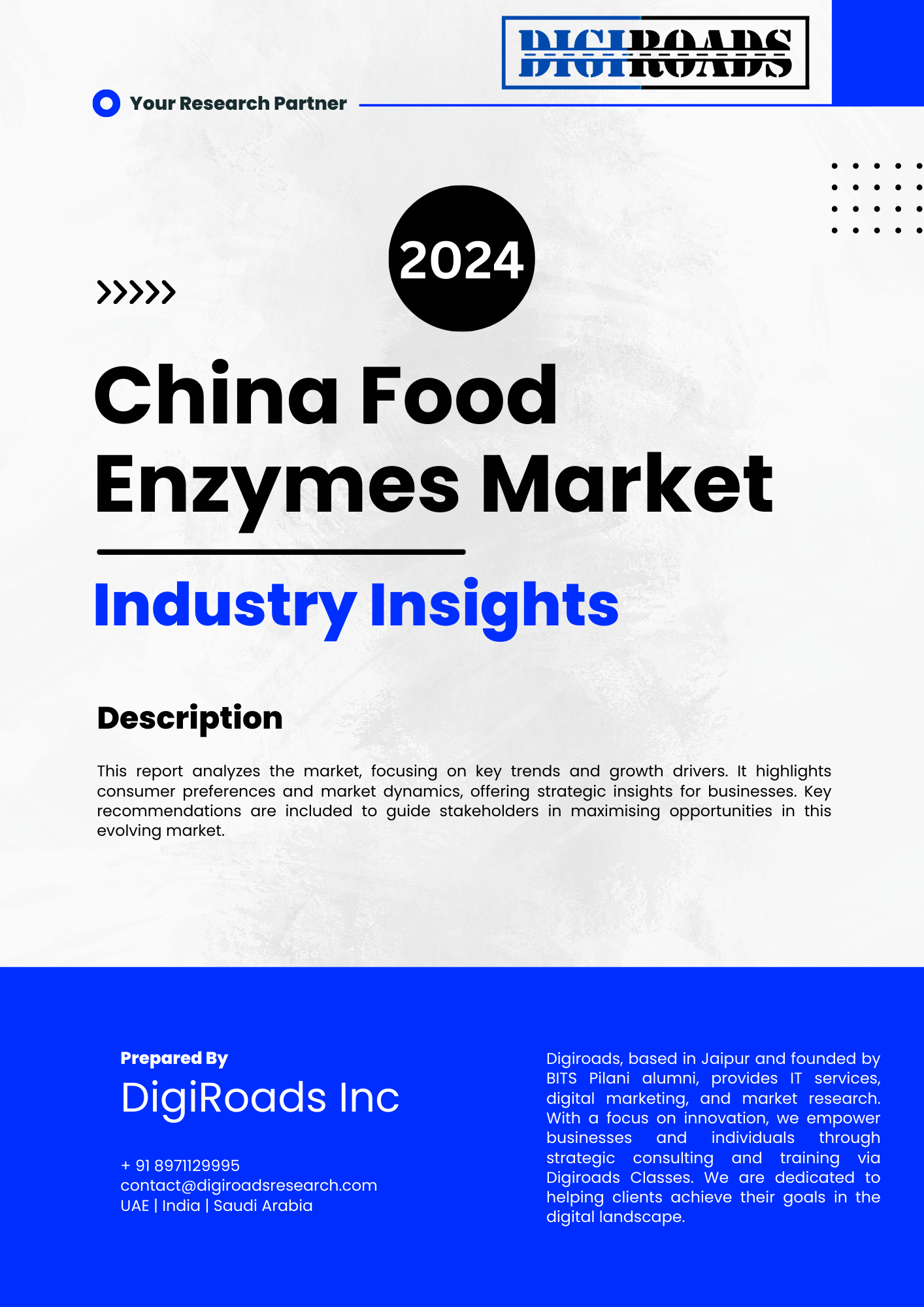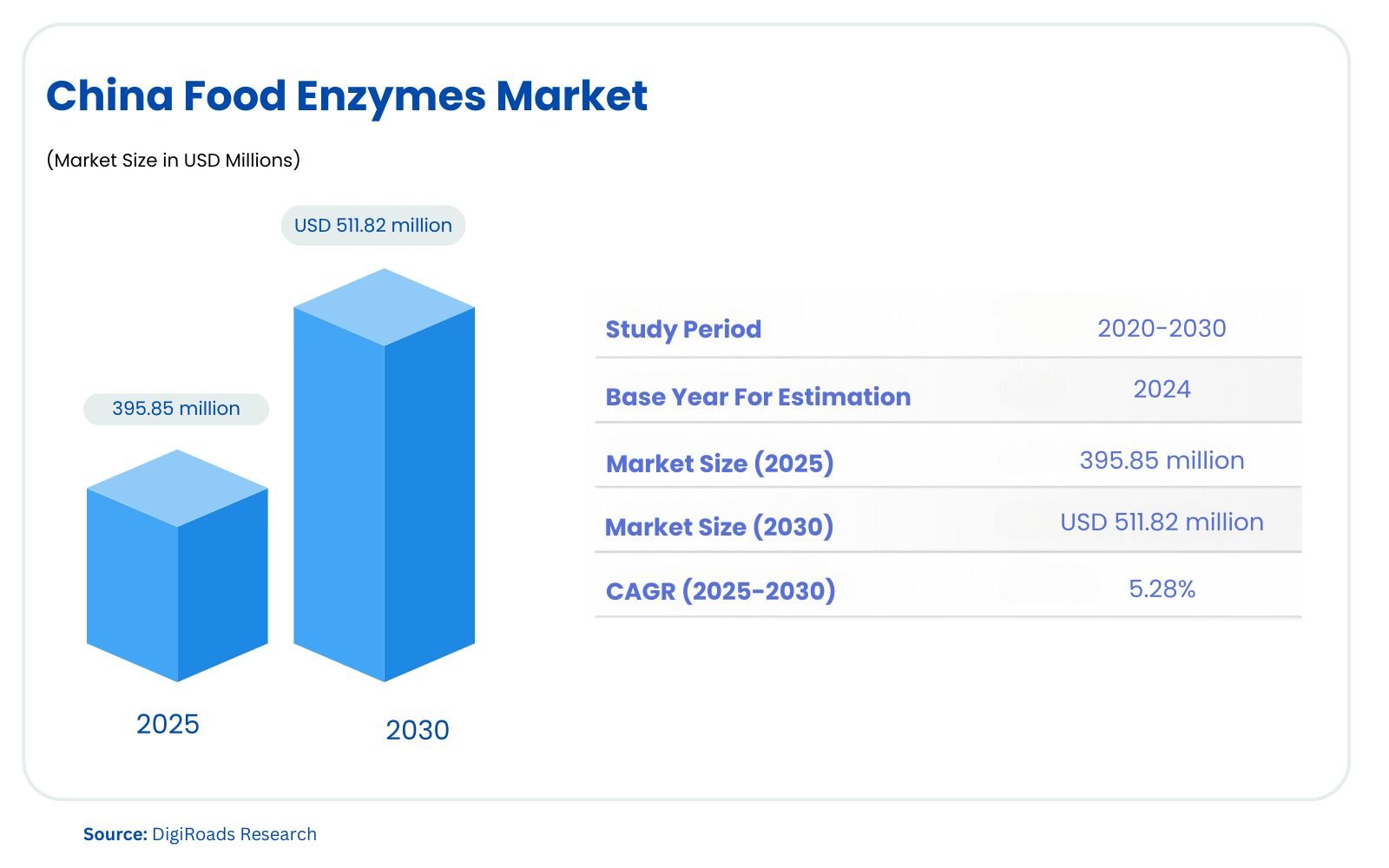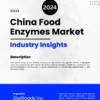China Food Enzymes Market
- Brand: DigiRoads
Explore the 100+ page report on the China Food Enzymes Market, offering insights into trends, growth drivers, and the competitive landscape. Available in PDF and Excel formats for convenient access to detailed data and analysis.
China Food Enzymes Market Report | Market Size, Industry Analysis, Growth Opportunities, & Forecast (2025-2030)
China Food Enzymes Market Overview
The China Food Enzymes Market is set to thrive, with an estimated market size of USD 395.85 million in 2025 and projected to reach USD 511.82 million by 2030, expanding at a CAGR of 5.28% during the forecast period 2025–2030. The China Food Enzymes Market is expected to experience steady growth from 2025 to 2030, driven by the increasing demand for specialized ingredients in the food industry. This market, which includes enzymes such as carbohydrases, proteases, and lipases, is benefiting from growing consumer interest in processed food products that offer convenience, nutritional value, and longer shelf life. Key sectors like bakery, dairy, and beverages are major consumers of food enzymes, with rising applications in enhancing product texture, flavor, and freshness. The market is also witnessing innovations, particularly in the use of enzymes for healthier formulations, such as low-fat or gluten-free products.
Several factors contribute to the market’s growth, including increasing disposable incomes, evolving consumer preferences for functional foods, and the continued focus on product innovation. Leading players such as Kerry Group, Novozymes, Koninklijke DSM N.V., and Chr. Hansen Holding A/S are actively investing in new enzyme technologies to meet consumer demands and stay ahead in the competitive landscape. The market is also supported by the growing adoption of enzyme solutions in the production of sports nutrition, supplements, and clean-label products, presenting significant opportunities for future growth.
This report provides a comprehensive analysis of the China Food Enzymes Market, including trends, opportunities, and competitive dynamics for the forecast period 2025-2030.
Market Report Coverage:
The “China Food Enzymes Market Report—Future (2025-2030)” by Digiroads Research & Consulting covers an in-depth analysis of the following segments in the market.
| By Type | Carbohydrases, Proteases, Lipases, Others |
| By Application | Bakery, Confectionery, Dairy and Frozen Desserts, Meat, Poultry and Seafood Products, Beverages, Others |
Study Assumptions and Definitions
The China Food Enzymes Market report is based on a comprehensive analysis of the food enzyme industry within China, focusing on the period from 2025 to 2030. The report assumes steady market growth driven by increasing consumer demand for convenient, healthy, and long-lasting food products. The forecast is grounded in factors such as evolving dietary preferences, growing disposable incomes, and advancements in enzyme technology. The scope of this study includes the major food enzyme types such as carbohydrases, proteases, and lipases, and examines their applications in various food products including bakery, dairy, beverages, and more.
Market data and projections are derived from a combination of primary and secondary research, industry reports, and expert insights. Key assumptions include a sustained shift towards functional and clean-label foods, increased use of enzymes in specialized applications like gluten-free and sports nutrition products, and the ongoing development of new enzyme solutions by leading market players. The definitions of “food enzymes” include all enzymes that are safe for human consumption and used in food and beverage processing to improve product quality, shelf life, and nutritional value. The study also assumes that government regulations and consumer preferences will continue to evolve, influencing market dynamics.
Market Scope
The scope of the China Food Enzymes Market report covers a detailed analysis of the market dynamics, including drivers, restraints, opportunities, and competitive landscape from 2025 to 2030. It examines key enzyme types such as carbohydrases, proteases, and lipases, and their applications across various industries, including bakery, confectionery, dairy, frozen desserts, meat, poultry, seafood, and beverages. The study includes market sizing, forecasts, and trends for each segment, helping stakeholders understand growth prospects in different sectors.
This report provides an in-depth look at the key market players, such as Kerry Group, Novozymes, and Chr. Hansen Holding A/S, and their strategies to capitalize on emerging opportunities. Additionally, it explores the impact of consumer demand for functional and clean-label foods, innovations in enzyme applications, and the rising preference for health-focused products. The analysis also highlights market segmentation by type and application, offering a comprehensive overview of current and future market conditions.
MARKET OUTLOOK
Executive Summary
The China Food Enzymes Market is projected to experience significant growth from 2025 to 2030, driven by increasing consumer demand for processed foods that offer convenience, longer shelf life, and enhanced nutritional value. The market is expected to register a steady compound annual growth rate (CAGR) during this period. Enzymes, including carbohydrases, proteases, and lipases, play a crucial role in food processing, improving the texture, flavor, and freshness of various food products.
Key market drivers include the rising disposable incomes, evolving dietary preferences toward healthier foods, and increasing demand for functional foods. The bakery, dairy, and beverage sectors are the primary consumers of food enzymes, with enzymes increasingly being adopted to enhance product quality, texture, and shelf-life. Innovations in enzyme applications, such as their use in gluten-free, low-fat, and sports nutrition products, are further propelling market growth. Additionally, the growing popularity of clean-label products and natural ingredients is fueling the demand for specialty enzymes.
The market is also benefiting from the ongoing technological advancements and increasing investment by major players such as Kerry Group, Novozymes, Koninklijke DSM N.V., Chr. Hansen Holding A/S, and Amano Enzymes, who are focused on expanding their product portfolios and improving enzyme efficacy. The increasing penetration of protease-derived supplements in sports nutrition is also contributing to the market’s expansion.
Despite challenges like regulatory barriers and market competition, the China Food Enzymes Market presents lucrative growth opportunities. Manufacturers are expected to continue innovating and adapting to consumer trends, creating new enzyme solutions that cater to the evolving needs of the food and beverage industry. This report provides a detailed analysis of the market’s current state and future growth prospects, offering valuable insights for stakeholders and industry participants.
COMPETITIVE LANDSCAPE
The China Food Enzymes Market is moderately fragmented, with regional and multinational players competing fiercely for market share.
Key Market Players
- Kerry Group
- Novozymes
- Koninklijke DSM N.V.
- Amano Enzymes
- Chr. Hansen Holding A/S
- Jiangsu Boli Bioproducts Co. Ltd
- SinoBios
- XIKE Enzymes
Market Share Analysis
The China Food Enzymes Market is highly competitive, with several key players dominating the landscape. Novozymes, Kerry Group, Koninklijke DSM N.V., Chr. Hansen Holding A/S, and Amano Enzymes are among the leading companies, holding substantial market shares due to their strong product portfolios and technological advancements. Novozymes and DSM are particularly prominent in the carbohydrase and protease segments, offering a wide range of enzyme solutions for bakery, dairy, and beverage applications.
In recent years, there has been a noticeable shift towards natural and clean-label products, with companies like Chr. Hansen and Amano Enzymes capitalizing on the growing demand for sustainable, non-GMO enzyme solutions. The increasing adoption of enzymes in gluten-free, dairy-free, and sports nutrition products is further driving market share among players offering specialized enzyme solutions.
Smaller regional players, including Jiangsu Boli Bioproducts and SinoBios, are gaining traction by providing cost-effective and customized enzyme products to local manufacturers, contributing to market fragmentation. These companies often focus on niche applications and developing innovative solutions to cater to specific industry needs.
Overall, the market is expected to remain fragmented with intense competition among global leaders and emerging local players, each focusing on expanding their market share through product innovation, strategic partnerships, and geographical expansion.
MARKET DYNAMICS
Market Drivers and Key Innovations
The China Food Enzymes Market is being driven by several key factors, including the rising demand for processed and convenience foods, evolving consumer preferences for healthier, clean-label products, and innovations in food processing technology. As disposable incomes in China continue to grow, consumers are increasingly seeking foods that offer convenience, longer shelf life, and enhanced nutritional benefits. This shift in demand is prompting food manufacturers to explore new ways to improve product quality, texture, and shelf-life, which enzymes can efficiently address.
The growing trend of health-conscious eating has also spurred demand for functional foods, such as gluten-free, low-fat, and high-protein products, where enzymes play a critical role in improving taste, texture, and nutritional value. The rise in demand for plant-based and dairy-free foods is another key driver, with enzymes being used to improve the quality of these alternative products.
Key innovations in the market include the development of specialty enzymes tailored for specific applications, such as protease for protein fortification in sports nutrition products, and advancements in enzyme solutions for gluten-free and low-sugar products. Companies like Novozymes and Chr. Hansen are leading the charge in enzyme technology, offering new enzyme variants that enhance product quality and address consumer trends.
The increased focus on sustainability and clean-label ingredients has also spurred the development of enzymes that are non-GMO, organic, and natural. Innovations in enzyme formulations are enabling food manufacturers to offer more sustainable and transparent products, which align with the growing consumer demand for natural and healthy food options.
Market Challenges
- Regulatory and Compliance Issues: Stringent government regulations and approval processes for food additives, including enzymes, can create delays and complications for manufacturers seeking to introduce new products.
- High Production Costs: The cost of producing specialized enzymes, particularly for niche applications, can be high, limiting the affordability and accessibility of these products for smaller companies.
- Raw Material Availability: Fluctuations in the availability of raw materials for enzyme production, such as agricultural products for fermentation, can impact supply and increase costs.
- Market Fragmentation: With numerous local and international players in the market, competition is fierce, making it challenging for companies to maintain a significant market share.
- Consumer Awareness: Although there is growing interest in enzymes, consumer understanding of their benefits and functions remains limited. This could hinder widespread adoption, especially in smaller markets.
- Technological Limitations: While innovation in enzyme development is ongoing, there are still limitations regarding the efficiency and scalability of certain enzyme applications, particularly in complex or highly specialized food products.
- Sustainability Concerns: As demand for clean-label and sustainable products increases, companies may face challenges in ensuring that enzyme production processes are environmentally friendly and meet consumer expectations for eco-conscious practices.
Market Opportunities
- Immersive Technologies: Rising Demand for Functional Foods: As consumers increasingly seek healthier, fortified, and functional food products, there is a growing opportunity for enzymes to improve nutritional content, such as protein fortification and digestive aids.
- Expansion of Gluten-Free and Plant-Based Foods: The demand for gluten-free and plant-based food products is on the rise, offering significant growth opportunities for enzymes that improve the texture, taste, and nutritional profile of these products.
- Growth in the Baking Industry: The continuous demand for bakery products, including bread, cakes, and pastries, presents an opportunity for enzymes to enhance softness, shelf-life, and moisture retention, particularly with the increased focus on clean-label and healthier ingredients.
- Innovative Enzyme Solutions: The development of specialized enzymes for niche applications, such as enzymes for low-sugar, low-fat, and dairy-free products, offers new revenue streams for companies to tap into emerging consumer trends.
- Adoption of Clean-Label and Natural Enzymes: With increasing consumer demand for clean-label products, manufacturers can capitalize on producing non-GMO, organic, and natural enzymes to meet the growing preference for transparency and sustainability in food production.
- Technological Advancements in Enzyme Production: Advances in enzyme production technologies, such as fermentation improvements and genetic modifications, provide opportunities for companies to reduce costs and enhance the efficiency of enzyme applications.
- Rising Health Consciousness: As Chinese consumers become more health-conscious, there is an opportunity for enzyme-based products that offer health benefits, including improved digestion, weight management, and overall wellness.
RECENT STRATEGIES & DEVELOPMENTS IN THE MARKET
Partnerships and Joint Ventures:
- ADM and Qingdao Vland Biotech Group formed a joint venture in October 2021 to cater to the growing demand for probiotics and enzymes in China. This collaboration aims to strengthen their market presence and expand product offerings.
Product Launches and Innovations:
- Chr. Hansen launched the CHY-MAX Supreme enzyme in April 2019, which enables cheesemakers to increase cheese yield by up to 1%, demonstrating innovation in enzyme technology for the dairy industry.
- DSM introduced new enzyme solutions at IFT17 in June 2017, particularly for gluten-free bread, highlighting their commitment to catering to the growing demand for gluten-free products.
Expansion in Emerging Segments:
- Novozymes continues to innovate in the plant-based food sector, developing enzymes for improved texture, taste, and nutritional profiles. They are particularly focused on the growing plant-based meat and dairy alternatives market.
Sustainability and Clean Label Focus:
- Kerry Group has invested in developing enzymes that are clean-label and non-GMO, responding to consumer demand for natural and sustainable ingredients.
Increased Investment in R&D:
- Leading players, including Amano Enzymes and Novozymes, have increased their investment in research and development, with a focus on creating specialty enzymes for specific applications such as sports nutrition, dairy alternatives, and low-sugar products.
Acquisitions and Expansions:
- Novozymes has expanded its footprint in China by acquiring regional enzyme producers to enhance its product offerings and meet growing demand across various food applications.
These strategies reflect the market’s response to rising consumer demand for healthier, sustainable, and innovative food products, positioning companies to capitalize on emerging trends in the food industry.
KEY BENEFITS FOR STAKEHOLDERS
Market Expansion Opportunities:
- Stakeholders, such as manufacturers and distributors, can benefit from the growing demand for food enzymes across various applications, including bakery, dairy, beverages, and plant-based foods, presenting opportunities for increased market share.
Technological Advancements:
- With ongoing innovations in enzyme production, such as enhanced fermentation processes and genetically modified enzymes, stakeholders can leverage these advancements to improve product efficiency, reduce costs, and meet evolving consumer demands for functional and clean-label products.
Diversified Product Portfolio:
- Enzyme producers can broaden their product offerings to cater to niche markets, including gluten-free, low-sugar, and plant-based food products. This allows stakeholders to reach a wider consumer base and diversify revenue streams.
Health-Conscious Consumer Demand:
- The increasing health consciousness in China provides an opportunity for stakeholders to develop enzyme solutions that support digestive health, weight management, and overall wellness, thus attracting health-focused consumers.
Sustainability and Clean Label Trends:
- Companies focusing on natural, non-GMO, and sustainable enzyme solutions can tap into the growing demand for clean-label products, creating a competitive advantage in the marketplace.
Collaborations and Partnerships:
- Strategic partnerships, such as joint ventures and collaborations, allow stakeholders to leverage local expertise, expand distribution networks, and share R&D efforts, driving faster market penetration.
Regulatory Compliance and Market Entry:
- With ongoing regulatory approvals and the growing demand for food safety and quality standards, stakeholders can ensure compliance and expand their market reach by adhering to industry regulations and guidelines.
Profitability from Product Innovation:
- Stakeholders can capitalize on product innovation in enzyme applications, such as proteases and lipases for niche uses, leading to higher-value product offerings and improved profitability.
At DigiRoads Research, we emphasize reliability by employing robust market estimation and data validation methodologies. Our insights are further enhanced by our proprietary data forecasting model, which projects market growth trends up to 2030. This forward-thinking approach ensures our analysis not only captures the current market landscape but also anticipates future developments, equipping stakeholders with actionable foresight.
We go a step further by offering an exhaustive set of regional and country-level data points, supplemented by over 60 detailed charts at no additional cost. This commitment to transparency and accessibility allows stakeholders to gain a deep understanding of the industry’s structural and operational dynamics. By providing exclusive and hard-to-access data, DigiRoads Research empowers businesses to make informed strategic decisions with confidence.
In essence, our methodology and data delivery foster a collaborative and data-driven decision-making environment, enabling businesses to navigate industry challenges and capitalize on opportunities effectively.
Contact Us For More Inquiry.
Table of Contents
-
INTRODUCTION
- Market Overview
- Years Considered for Study
- Market Segmentation
- Study Assumptions and Definitions
- Market Scope
-
RESEARCH METHODOLOGY
-
MARKET OUTLOOK
- Executive Summary
- Market Snapshot
- Market Segments
- By Type:
- Carbohydrases, Proteases, Lipases, Others
- By Application:
- Bakery, Confectionery, Dairy and Frozen Desserts, Meat, Poultry and Seafood Products, Beverages, Others
- By Type:
-
COMPETITIVE LANDSCAPE
- Recent Strategies (Key Strategic Moves)
- Market Share Analysis
- Company Profiles
- Kerry Group
- Novozymes
- Koninklijke DSM N.V.
- Amano Enzymes
- Chr. Hansen Holding A/S
- Jiangsu Boli Bioproducts Co. Ltd
- SinoBios
- XIKE Enzymes
-
MARKET DYNAMICS
- Market Drivers
- Market Challenges
- Market Opportunities
- Porter’s Five Forces’ Analysis
- Bargaining Power of Suppliers
- Bargaining Power of Buyers
- Threat of New Entrant
- Threat of Substitutes
- Competitive Rivalry
-
GLOSSARY OF PROMINENT SECONDARY SOURCES
-
DISCLAIMER
-
ABOUT US



